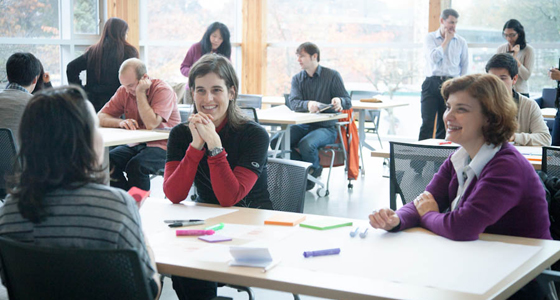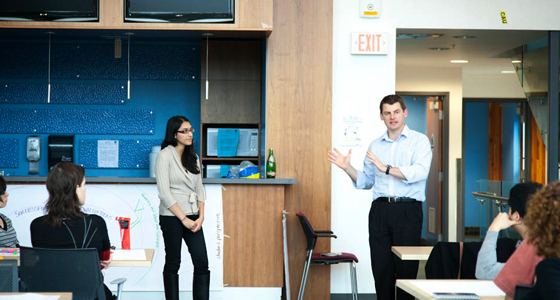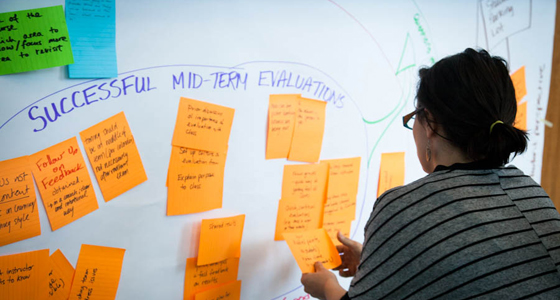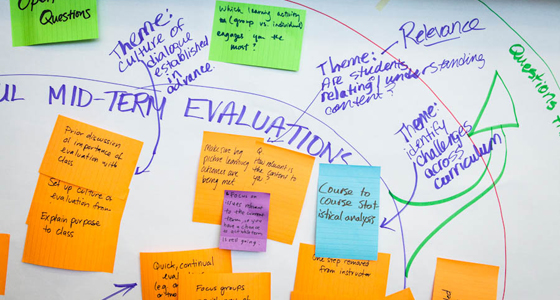 The hands-on event, Midterm Evaluations of Teaching Forum, part of Celebrate Learning Week, provided a setting for instructors and students to collaboratively discuss ways to make midterm evaluations meaningful for both parties involved. Midterm evaluations are distributed halfway through a course and allow the instructor to gauge what the students think of the class so far. If delivered in a meaningful way, they can offer substantial benefits to both the instructors and the students.
The hands-on event, Midterm Evaluations of Teaching Forum, part of Celebrate Learning Week, provided a setting for instructors and students to collaboratively discuss ways to make midterm evaluations meaningful for both parties involved. Midterm evaluations are distributed halfway through a course and allow the instructor to gauge what the students think of the class so far. If delivered in a meaningful way, they can offer substantial benefits to both the instructors and the students.
Presented in a World Cafe style format, the event focussed on two questions: “what does a successful midterm evaluation of teaching look like,” and “what questions should you (or should you not) ask on a midterm evaluation?” In addition to exploring the most valuable ways to collect students’ opinions about various aspects of a course, participants engaged in insightful conversations about how to effectively follow up with students after they have submitted their feedback. The tables were impressively covered with large blank sheets of paper and an array of vibrantly coloured markers and post-it note pads. Two banner-sized sheets of paper were spread out in preparation for an activity, displaying a mind-map waiting to be populated with the ideas of the participants.
 An introduction was made by Dr. Simon Bates, Senior Advisor, Teaching and Learning, and Academic Director of CTLT, and Kiran Mahal, VP Academic and University Affairs of the Alma Mater Society (AMS). The idea for this event came from the aspiration to create better dialogue between instructors and students on midterm evaluations of teaching. Currently, only the Sauder School of Business requires instructors to conduct these evaluations. Based on their model, a pilot project of midterm evaluations of teaching is being conducted in partnership with the AMS and CTLT during this academic year. The evaluation is presented as a survey, and the initial pilot was conducted during the September-December 2012 school term, with 25 courses participating in the pilot. Although given guidance as to what questions should be put on their survey, it was ultimately left up to each instructor to create their own midterm evaluations, based on their needs.
An introduction was made by Dr. Simon Bates, Senior Advisor, Teaching and Learning, and Academic Director of CTLT, and Kiran Mahal, VP Academic and University Affairs of the Alma Mater Society (AMS). The idea for this event came from the aspiration to create better dialogue between instructors and students on midterm evaluations of teaching. Currently, only the Sauder School of Business requires instructors to conduct these evaluations. Based on their model, a pilot project of midterm evaluations of teaching is being conducted in partnership with the AMS and CTLT during this academic year. The evaluation is presented as a survey, and the initial pilot was conducted during the September-December 2012 school term, with 25 courses participating in the pilot. Although given guidance as to what questions should be put on their survey, it was ultimately left up to each instructor to create their own midterm evaluations, based on their needs.
Facilitating the session were CTLT’s Cindy Underhill, Strategist, Learning Resource Design, and Janet McCracken, Instructional Designer/Project Manager, who helped lead participants through the World Cafe style discussion. Participants were asked to engage with their group in discussion on the first question: what does a successful midterm evaluation look like? Members of each group were encouraged to brainstorm on the large sheets of paper in front of them, and then write down key words on the sticky notes. After ample time for collaboration, everyone was asked to bring their contributions to the front of the room to stick right in the centre circle of the mind-map banner, with the heading ‘successful midterm evaluations.’ After all the input was collected, and with all the groups gathered around the banner, the facilitators moved the sticky notes around to form connections between all of the thoughts.
 Then, following the typical World Cafe format, all but one of the members at each of the tables was asked to find a new table to begin on the next discussion topic. Groups were asked to brainstorm types of questions that support a successful midterm evaluation, and types of questions that might detract from one. Some tables were actively diagramming their ideas while others approached the questions with verbal discussion, bouncing questions off of each other, which created tangents that led to more deep-seeded conversation. The facilitators, meanwhile, continued to walk around and pose questions to the groups to help them better connect to the questions. Almost every table had a student’s perspective to balance the discussion that applied and affected students as much as, or even more so, than the instructors. Groups were also asked to consider the challenges students may face in the process, as well as possible challenges instructors may have. After another period of discussion to fully flesh out all of the ideas, groups were again asked to stick the ideas on their post-it notes. The banner had quickly become a collage of orange, purple, blue, green, and pink, and gathered all together, participants were asked to identify the different themes of successful midterm evaluations. The themes that most accurately represented what the discussions had been about were: identifying challenges across the curriculum, ensuring students are relating to the content, giving quick feedback, and sharing results with students. Elaborating on the last theme, Dr. Bates emphasized that the importance of the dialogue between students and instructors, after the feedback has been assessed, is greater than what the students actually write. This is true even though the evaluation they give is the catalyst that sparks the follow-up dialogue. Success starts with establishing a culture of conversation before the middle of term, and explaining to students the purpose of the evaluations in advance. With this mindset, Dr. Bates hopes that the evaluations will truly help facilitate insight into best practices of teaching.
Then, following the typical World Cafe format, all but one of the members at each of the tables was asked to find a new table to begin on the next discussion topic. Groups were asked to brainstorm types of questions that support a successful midterm evaluation, and types of questions that might detract from one. Some tables were actively diagramming their ideas while others approached the questions with verbal discussion, bouncing questions off of each other, which created tangents that led to more deep-seeded conversation. The facilitators, meanwhile, continued to walk around and pose questions to the groups to help them better connect to the questions. Almost every table had a student’s perspective to balance the discussion that applied and affected students as much as, or even more so, than the instructors. Groups were also asked to consider the challenges students may face in the process, as well as possible challenges instructors may have. After another period of discussion to fully flesh out all of the ideas, groups were again asked to stick the ideas on their post-it notes. The banner had quickly become a collage of orange, purple, blue, green, and pink, and gathered all together, participants were asked to identify the different themes of successful midterm evaluations. The themes that most accurately represented what the discussions had been about were: identifying challenges across the curriculum, ensuring students are relating to the content, giving quick feedback, and sharing results with students. Elaborating on the last theme, Dr. Bates emphasized that the importance of the dialogue between students and instructors, after the feedback has been assessed, is greater than what the students actually write. This is true even though the evaluation they give is the catalyst that sparks the follow-up dialogue. Success starts with establishing a culture of conversation before the middle of term, and explaining to students the purpose of the evaluations in advance. With this mindset, Dr. Bates hopes that the evaluations will truly help facilitate insight into best practices of teaching.
 Everyone was asked to rotate one last time and quickly brainstorm what some specific midterm evaluation questions may look like. One specific question that sparked particular praise from the whole group was “what can you do as a student to improve your learning?” From a discussion on that topic, another important question rose up about what is really being evaluated. One participant asked if they had just spent two and a half hours discussing midterm evaluations of teaching, or if was a broader discussion on student learning. Dr. Bates’s answer to that was “it is honestly a combination of both.” He was quick to add that the gravity of the discussion that occurred during the session may in fact change whole aspects of the pilot project. He explained that the information that had been compiled by the efforts of the participants would be further shared and considered. Dr. Bates added that a UBC Wiki page will be created for further collaboration as they continue to take action on the pilot project, and offered his thanks to the active participants who so willingly came together to collaborate in this practical learning experience.
Everyone was asked to rotate one last time and quickly brainstorm what some specific midterm evaluation questions may look like. One specific question that sparked particular praise from the whole group was “what can you do as a student to improve your learning?” From a discussion on that topic, another important question rose up about what is really being evaluated. One participant asked if they had just spent two and a half hours discussing midterm evaluations of teaching, or if was a broader discussion on student learning. Dr. Bates’s answer to that was “it is honestly a combination of both.” He was quick to add that the gravity of the discussion that occurred during the session may in fact change whole aspects of the pilot project. He explained that the information that had been compiled by the efforts of the participants would be further shared and considered. Dr. Bates added that a UBC Wiki page will be created for further collaboration as they continue to take action on the pilot project, and offered his thanks to the active participants who so willingly came together to collaborate in this practical learning experience.

